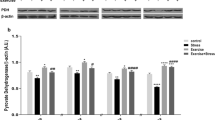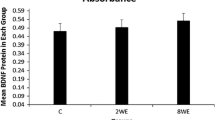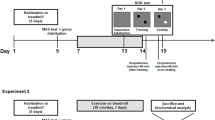Abstract
Neurotrophic factors and exercise training are effective in the growth and survival of neuronal cells. These factors play a protective role against oxidative stress damage and have the same function as antioxidants. The purpose of this study was to investigate the effect of a session of endurance training with three different intensities on CDNF, SOD, and MDA levels of cerebral cortex in male rats. Thirty-two male Wistar rats (aged 20 weeks) were divided randomly into two control and training groups. The training group consisted of low-, moderate-, and high-intensity trainings. The training groups, after getting familiarization with the rodent treadmill, were dealt with an acute training session with three different intensities. The CDNF level of cerebral cortex was measured by ELISA assay, and the SOD and MDA levels of cerebral cortex by spectrophotometery. A significant difference was seen in the CDNF level between low- and high-intensity groups, as well as between high-intensity groups and control group (P = 0.001). The levels of SOD were increased significantly among all groups (except for control and low-intensity groups). The acute training with different intensities significantly prevents the increase in MDA level of cerebral cortex (P = 0.005). The result of this study shows that the physical exercise even in the short term can affect the protective factors and antioxidant system in neuronal cells. However, the benefits of high-intensity training were higher than others. Therefore, suggested that the role of acute exercise with different intensities should be carefully considered for the preconditioning against neuronal degenerative diseases.



Similar content being viewed by others
Abbreviations
- CDNF:
-
Cerebral dopamine neurotrophic factor
- SOD:
-
Superoxide dismutase
- MAD:
-
Malondialdehyde
References
Abhijit S, Tripathi SJ, Bhagya V, Rao BS, Subramanyam MV, Devi SA (2018) Antioxidant action of grape seed polyphenols and aerobic exercise in improving neuronal number in the hippocampus is associated with decrease in lipid peroxidation and hydrogen peroxide in adult and middle-aged rats. Exp Gerontol 101:101–112
Al-Jarrah M (2013) Exercise training and rehabilitation of the brain in Parkinson’s disease. Clin Med Res 2(2):11–17
Apostolova L, Alves G, Hwang KS, Babakchanian S, Bronnick KS, Larsen JP et al (2012) Hippocampal and ventricular changes in Parkinson’s disease mild cognitive impairment. Neurobiol Aging 33(9):2113–2124
Aslani J, Moghaddam A, Mohammadi Z, Ismaili A, Mohammadi R (2015) Effects of hydro-alcoholic extract of Eriobotrya japonica Lindl. flowers on CDNF, SOD and MDA levels of cerebral cortex in experimental model of Parkinson’s disease in rat. Iran J Med Aromat Plants 31(2):332–341
Bayod S, Del Valle J, Pelegri C, Vilaplana J, Canudas A, Camins A et al (2014) Macroautophagic process was differentially modulated by long-term moderate exercise in rat brain and peripheral tissues. J Physiol Pharmacol 65(2):229–239
Beckman JS (1994) Peroxynitrite versus hydroxyl radical: the role of nitric oxide in superoxide-dependent cerebral injury. Ann N Y Acad Sci 738(1):69–75
Berchtold N, Chinn G, Chou M, Kesslak J, Cotman C (2005) Exercise primes a molecular memory for brain-derived neurotrophic factor protein induction in the rat hippocampus. Neuroscience 133(3):853–861
Carey RJ, Pinheiro-Carrera M, Dai H, Tomaz C, Huston JP (1995) L-DOPA and psychosis: evidence for L-DOPA-induced increases in prefrontal cortex dopamine and in serum corticosterone. Biol Psychiatry 38(10):669–676
Chalimoniuk M, Jagsz S, Sadowska-Krepa E, Chrapusta S, Klapcinska B, Langfort J (2015) Diversity of endurance training effects on antioxidant defenses and oxidative damage in different brain regions of adolescent male rats. J Physiol Pharmacol 66(4):539–547
Chan PH (1996) Role of oxidants in ischemic brain damage. Stroke 27(6):1124–1129
Chirico EN, Di Cataldo V, Chauveau F, Geloën A, Patsouris D, Thézé B et al (2016) Magnetic resonance imaging biomarkers of exercise-induced improvement of oxidative stress and inflammation in the brain of old high-fat-fed ApoE−/− mice. J Physiol 594(23):6969–6985
Cohen AD, Tillerson JL, Smith AD, Schallert T, Zigmond MJ (2003) Neuroprotective effects of prior limb use in 6-hydroxydopamine-treated rats: possible role of GDNF. J Neurochem 85(2):299–305
Cotman CW, Berchtold NC, Christie L-A (2007) Exercise builds brain health: key roles of growth factor cascades and inflammation. Trends Neurosci 30(9):464–472
Di Meo S, Venditti P (2001) Mitochondria in exercise-induced oxidative stress. Neurosignals 10(1–2):125–140
Dong J, Zhao J, Lin Y, Liang H, He X, Zheng X, Sui M, Zhuang Z, Yan T (2018) Exercise improves recognition memory and synaptic plasticity in the prefrontal cortex for rats modelling vascular dementia. Neurol Res 40(1):68–77
Ferreira AF, Real CC, Rodrigues AC, Alves AS, Britto LR (2011) Short-term, moderate exercise is capable of inducing structural, BDNF-independent hippocampal plasticity. Brain Res 1425:111–122
Gerlach M, Riederer P (1996) Animal models of Parkinson’s disease: an empirical comparison with the phenomenology of the disease in man. J Neural Transm 103(8–9):987–1041
Hellman M, Peränen J, Saarma M, Permi P (2010) 1 H, 13 C and 15 N resonance assignments of the human mesencephalic astrocyte-derived neurotrophic factor. Biomol NMR Assign 4(2):215–217
Houston MC, Fazio S, Chilton FH, Wise DE, Jones KB, Barringer TA, Bramlet DA (2009) Nonpharmacologic treatment of dyslipidemia. Prog Cardiovasc Dis 52(2):61–94
Johnson R, Rhodes J, Jeffrey S, Garland T Jr, Mitchell G (2003) Hippocampal brain-derived neurotrophic factor but not neurotrophin-3 increases more in mice selected for increased voluntary wheel running. Neuroscience 121(1):1–7
Katusic ZS, Austin SA (2013) Endothelial nitric oxide: protector of a healthy mind. Eur Heart J 35(14):888–894
Lefevre G, Beljean-Leymarie M, Beyerle F, Bonnefont-Rousselot D, Cristol J-P, Therond P, Torreilles J (1998) Evaluation of lipid peroxidation by assaying the thiobarbituric acid-reactive substances. Paper presented at the Annales de biologie clinique
Li J, Wang Y (2013) Effect of different methods of hypoxic exercise training on free radical oxidation and antioxidant enzyme activity in the rat brain. Biomed Rep 1(6):925–929
Liguz-Lecznar M, Skangiel-Kramska J (2007) Vesicular glutamate transporters (VGLUTs): the three musketeers of glutamatergic system. Acta Neurobiol Exp 67(3):207–218
Lindholm P, Saarma M (2010) Novel CDNF/MANF family of neurotrophic factors. Dev Neurobiol 70(5):360–371
Lindholm P, Voutilainen MH, Laurén J, Peränen J, Leppänen V-M, Andressoo J-O et al (2007) Novel neurotrophic factor CDNF protects and rescues midbrain dopamine neurons in vivo. Nature 448(7149):73–77
Lotharius J, Dugan LL, O’malley KL (1999) Distinct mechanisms underlie neurotoxin-mediated cell death in cultured dopaminergic neurons. J Neurosci 19(4):1284–1293
Lou S-J, Liu J-Y, Chang H, Chen P-J (2008) Hippocampal neurogenesis and gene expression depend on exercise intensity in juvenile rats. Brain Res 1210:48–55
Lovlin R, Cottle W, Pyke I, Kavanagh M, Belcastro A (1987) Are indices of free radical damage related to exercise intensity. Eur J Appl Physiol Occup Physiol 56(3):313–316
Mabandla MV, Russell VA (2010) Voluntary exercise reduces the neurotoxic effects of 6-hydroxydopamine in maternally separated rats. Behav Brain Res 211(1):16–22
Mattson MP, Magnus T (2006) Ageing and neuronal vulnerability. Nat Rev Neurosci 7(4):278–294
Naderi A, Alaei H, Sharifi M, Hoseini M (2007) The comparison between effect of short-term and mid-term exercise on the enthusiasm of the male rats to self-administer morphine. Iranian Journal of Basic Medical Sciences 4(32):272–280
Olanow C (1990) Oxidation reactions in Parkinson’s disease. Neurology 40(10 Suppl 3):suppl 32–suppl 37 discussion 37-39
Palasz E, Folcik R, Gasiorowska A, Niewiadomski W, Niewiadomska G (2018) Treadmill training lessens dopaminergic deficiency, enhances BDNF and GDNF biosynthesis, and reduces brain inflammation in the MPTP mouse model of Parkinson’s disease. Parkinsonism Relat Disord 46:e41
Pietrelli A, López-Costa JJ, Goñi R, López EM, Brusco A, Basso N (2011) Effects of moderate and chronic exercise on the nitrergic system and behavioral parameters in rats. Brain Res 1389:71–82
Radak Z, Kumagai S, Taylor AW, Naito H, Goto S (2007) Effects of exercise on brain function: role of free radicals. Appl Physiol Nutr Metab 32(5):942–946
Radak Z, Chung HY, Koltai E, Taylor AW, Goto S (2008) Exercise, oxidative stress and hormesis. Ageing Res Rev 7(1):34–42
Rhodes JS, Gammie SC, Garland T Jr (2005) Neurobiology of mice selected for high voluntary wheel-running activity. Integr Comp Biol 45(3):438–455
Sackner M (2012) Whole body periodic acceleration:“passive exercise” for Parkinson’s disease. Journal of Parkinsonism & Restless Legs Syndrome 2(1):1–5
Sadowska-Krępa E, Kłapcińska B, Jagsz S, Sobczak A, Chrapusta SJ, Chalimoniuk M, Grieb P, Poprzęcki S, Langfort J (2011) High-dose testosterone propionate treatment reverses the effects of endurance training on myocardial antioxidant defenses in adolescent male rats. Cardiovasc Toxicol 11(2):118–127
Sadowska-Krepa E, Klapcinska B, Jagsz S, Chalimoniuk M, Chrapusta S, Wanke A et al (2013) Diverging oxidative damage and heat shock protein 72 responses to endurance training and chronic testosterone propionate treatment in three striated muscle types of adolescent male rats. J Physiol Pharmacol 64(5):639–647
Sautter J, Kupsch A, Earl C, Oertel W (1997) Degeneration of pre-labelled nigral neurons induced by intrastriatal 6-hydroxydopamine in the rat: behavioural and biochemical changes and pretreatment with the calcium-entry blocker nimodipine. Exp Brain Res 117(1):111–119
Shirvani H, Arabzadeh E (2018) Metabolic cross-talk between skeletal muscle and adipose tissue in high-intensity interval training vs. moderate-intensity continuous training by regulation of PGC-1α. Eating and Weight Disorders-Studies on Anorexia, Bulimia and Obesity 1–8. https://doi.org/10.1007/s40519-018-0491-4
Shirvani H, Aslani J (2017) The effects of high-intensity interval training vs. moderate-intensity continuous training on serum irisin and expression of skeletal muscle PGC-1α gene in male rats. Tehran Univ Med J TUMS Publ 75(7):513–520
Shirvani H, TaheriChadorneshin H, Sarir H, Aslani J (2017) Neuroprotective effects of voluntary wheel running and eriobotrya japonica flower extract on Parkinsonian rats. J Kerman Univ Med Sci 24(4):289–297
Smith MP, Cass WA (2007) GDNF reduces oxidative stress in a 6-hydroxydopamine model of Parkinson’s disease. Neurosci Lett 412(3):259–263
Stern MB (1993) Parkinson’s disease: early diagnosis and management. J Fam Pract 36(4):439–447
Sun ZP, Gong L, Huang SH, Geng Z, Cheng L, Chen ZY (2011) Intracellular trafficking and secretion of cerebral dopamine neurotrophic factor in neurosecretory cells. J Neurochem 117(1):121–132
Swain RA, Harris AB, Wiener EC, Dutka MV, Morris HD, Theien BE, Konda S, Engberg K, Lauterbur PC, Greenough WT (2003) Prolonged exercise induces angiogenesis and increases cerebral blood volume in primary motor cortex of the rat. Neuroscience 117(4):1037–1046
Van Praag H (2008) Neurogenesis and exercise: past and future directions. NeuroMolecular Med 10(2):128–140
Venditti P, Di Meo S (1996) Antioxidants, tissue damage, and endurance in trained and untrained young male rats. Arch Biochem Biophys 331(1):63–68
Wu S-Y, Wang T-F, Yu L, Jen CJ, Chuang J-I, Wu F-S, Wu CW, Kuo Y-M (2011) Running exercise protects the substantia nigra dopaminergic neurons against inflammation-induced degeneration via the activation of BDNF signaling pathway. Brain Behav Immun 25(1):135–146
Yoon M-C, Shin M-S, Kim T-S, Kim B-K, Ko I-G, Sung Y-H, Kim SE, Lee HH, Kim YP, Kim C-J (2007) Treadmill exercise suppresses nigrostriatal dopaminergic neuronal loss in 6-hydroxydopamine-induced Parkinson’s rats. Neurosci Lett 423(1):12–17
Zhang Z, Fan J, Ren Y, Zhou W, Yin G (2013) The release of glutamate from cortical neurons regulated by BDNF via the TrkB/Src/PLC-γ1 pathway. J Cell Biochem 114(1):144–151
Acknowledgments
We acknowledge the Department of Exercise Physiology, University of Mazandaran for their contributions.
Author information
Authors and Affiliations
Corresponding author
Ethics declarations
This study was conducted according to the Declaration of Helsinki guidelines and approved by the Ethical Committee of Mazandaran University (Ethical cod #IR.BMSU.REC.1395.987).
Conflict of interest
The authors declare that they have no conflict of interest.
Additional information
Publisher’s Note
Springer Nature remains neutral with regard to jurisdictional claims in published maps and institutional affiliations.
Rights and permissions
About this article
Cite this article
Shirvani, H., Aslani, J., Fallah Mohammadi, Z. et al. Short-term effect of low-, moderate-, and high-intensity exercise training on cerebral dopamine neurotrophic factor (CDNF) and oxidative stress biomarkers in brain male Wistar rats. Comp Clin Pathol 28, 369–376 (2019). https://doi.org/10.1007/s00580-018-2885-0
Received:
Accepted:
Published:
Issue Date:
DOI: https://doi.org/10.1007/s00580-018-2885-0




